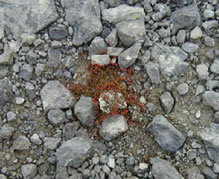Biology of Haughton Crater
by Charles Cockell


A patch of flowers in Haughton Crater.
 |
|
The Haughton Impact Crater is set in a polar desert
biome in the high arctic. Although finding environments
that are exactly Mars-like is impossible on earth, an impact
crater in a polar region is the best analog we have. Our
work is focused on
understanding the types of
habitats that are made possible
by an impact event and the types
of life that colonize craters. We
are studying the cyanobacteria
(an ancient lineage of
photosynthetic bacteria) that
live in the impact shocked rocks
and we are examining the types
of microbes that live in the lakes
inside the crater, particularly the
cyanobacterial mats. If there
was ever life on Mars, then this crater might be used to
refine our search criteria for life. We are also interested in
studying how these microbes survive the extreme
environment by examining the types of UV screening
compounds they produce to protect themselves from 24
hours of UV exposure, since UV radiation on Mars is 1,000
times more damaging to DNA than on earth. In addition to
its relevance to Mars, our work will
provide valuable insights into the
patterns of colonization in craters in
general and also the biology of high
arctic deserts. By characterizing the
microbial populations of the crater we
contribute towards other work in
Canada to understand the ecology of
the high arctic. Over the next few
years we will incorporate the biology
program at Haughton with simulated
mars exploration from the Mars Arctic
Research Station.
|

